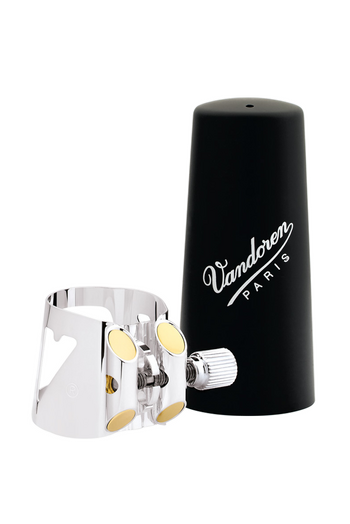Do Ligatures Really Make a Difference?
by Mitchell Estrin
Date Posted: September 14, 2016
One of the questions I am frequently asked by my students and at masterclasses is whether ligatures really do make a difference. The simple answer is yes, they do. So the question then becomes why.
A small historical detour is necessary here. From the invention of the clarinet in the early eighteenth century up until the late nineteenth and early twentieth centuries, players tied their reed to the mouthpiece with string. Some players would coat the string with bees wax for a better hold. Mouthpieces would sometimes have grooves cut into them to give the string a place to sit. Having the reed held in place with a wrapped string made it difficult and time consuming to change reeds and a little risky when changing clarinets (B-flat to A) in the orchestra. With the industrial revolution came the development of the familiar metal two screw ligature which offered greater security and ease of changes.

Let us consider first the prime directive of a ligature which is to properly hold the reed in place on the mouthpiece. As mouthpieces often are different circumferences, how a ligature fits on and around your mouthpiece is priority number one. Assuming it fits well, the next point is that the screws should always be to the right as you are looking down at your instrument when in playing position.
This brings up the traditional -screws on the bottom - versus the inverted - screws on the top - ligature concepts. Prior to the mid-twentieth century, almost all ligatures were traditional style. The great clarinetist and pedagogue, Daniel Bonade, was the pioneer of the inverted ligature. He may not have invented it, but he certainly refined and popularized the concept. By having the screws on the top, Bonade was able to use the bottom (solid side) of the ligature solely for the purpose of maximizing and/or controlling the vibrations of the reed on the mouthpiece. Many other designers and manufacturers soon followed suit.
"You will be amazed at the variety of tonal characteristics you will hear (as listener) and the variations in response you will feel (as player)." - Mitchell Estrin
Another variance from one ligature to another is the manner in which the reed is held in place. Traditional ligatures generally have their entire length coming into contact with the reed. This places equal pressure on all parts of the reed with which it comes into contact. Other ligatures, both traditional and inverted, will feature select pressure points - sometimes vertical, sometimes horizontal, and often 4-6 small points strategically shaped and placed by the designer. All of these variations will change the overall musical effect.
The main musical differences between ligatures are how they respond to blowing pressure and what kind of tone color they produce. Another huge factor in how a ligature affects the response and tone color is the material from which the ligature is made. Each material or plating, be it metal, precious metal, plastic, string, cloth, etc. will vibrate differently, thus giving a unique response and tone color. Also, although the same brand and model of ligature will share certain characteristics, no two will play or sound exactly alike.
In case you are a doubter, try a blindfold test, both as a player and a listener. You will be amazed at the variety of tonal characteristics you will hear (as listener) and the variations in response you will feel (as player). The most glaring differences will be noted in timbre, articulation, and when executing extreme dynamic levels, particularly pianissimo.
Although choosing a great ligature may seem a little daunting at first, the good news is that in today's marketplace, there is truly something for everyone. My best advice is to play test 6-10 ligatures as both listener and player, make a choice and never look back. My current choice is the Vandoren MO in pewter.
Best of luck finding your ideal ligature and remember they really do make a difference!